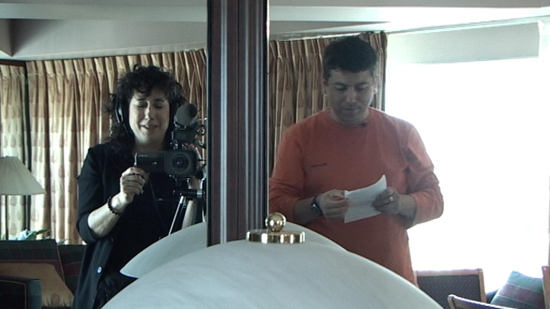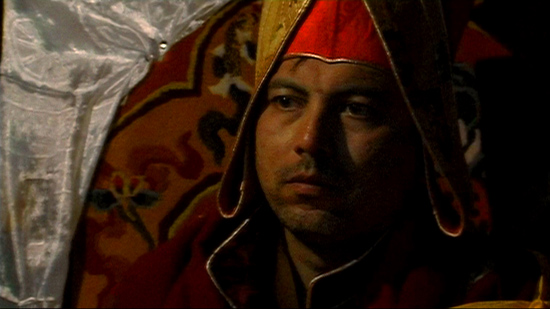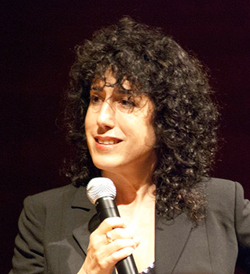Yesterday, the profoundly generous Jennifer Fox shared with us four more of the lessons she learned crowdfunding. This after a run two week’s earlier where she shared a host of other (1st six here, next 14 here, next 9 here).
Since then, she has gone down in the record books for both the number of donations and the amount thereof. Jennifer continues her path of profound generosity with another wave of the demystification wand to show how it was done. It is not magic; it’s hard work — but it can be done, and learned from. Read the next four today.
33. How Many Times Does It Take? The Rule of Three (at least):
For many years I heard distributors say that you have to hear the name
of a film three times before you will go to see it in the movie theater
(the same applies for purchasing any new product). I am not sure why
this is the case, but the idea is that you have to have a new idea
reinforced several times and several ways before you will take decisive
action.
This is something I noticed over and over during the MY REINCARNATION
campaign. People did not act the first time we sent them an
announcement but somewhere down the line – email blast or
Facebook Post number 3, 4, 5 or 6 (that they actually read) – they
decided to become a patron. Of course this it totally different
for those who have heard of the project before – like your
long-suffering family and friends – who have been listening to you talk
about your dear film ad nausea and make a donation if for no other
reason than to have some peace and quiet.
But for strangers and for those who don’t have an emotional attachment
to you, the key is to give reasons to keep reading, watching and
considering the project so they can hear about it several times and
pass their individual saturation point or “tipping point” to make a
contribution. But to keep them engaged till they make their decision to
become a patron, takes some work…

34. “If You Give, You Shall Receive”:
During the course of our Kickstarter campaign,
I became so fired up with crowd-funding that I found myself really
sympathetic to email appeals I received to help complete other films on
both IndieGoGo and Kickstarter.
I found myself making small (I am broke after all) $10 to $25 donations
to other film projects I liked. What happened was surprising.
Inevitably when I gave a donation to someone they made a donation back
to our project. While we didn’t exactly make huge sums from this, it
expanded the awareness of the project and they became part of the
film’s community (see previous Tip #25). I found this very interesting.
It made me realize that another thing my Mother told me was true. When
I was grown up, my Mom made a post motherhood career change to become a
professional fundraiser for deafness research and created a foundation
called NOHR (The National
Organization for Hearing Research). She always said that it is
important that she make donations to all her local charities and go to
their events if she wants people to give to her foundation. I always
found this idea strange, until I saw it happen on Kickstarter.
35. ‘New News’:
Previously I spoke about the idea that our team approached our Kickstarter campaign with the idea that there would be a “rollout” (see previous Tip #3), many people asked me what I meant by this.
A “rollout” means that you have to constantly create new reasons for
people to keep checking your site and read your email blasts.
This may not be so true on a shorter campaign but on a longer campaign
like ours, which lasted 90 days, it becomes absolutely evident. So the
question becomes: what new incentives are you giving your audience to
continue their involvement or begin their involvement? I have already
said in the previous post that fundraising is not a passive act (previous Tip #26); you must grab that potential patron’s attention.
Once you launch your Kickstarter campaign, the excitement of what you
are offering – the new video appeal, all those new wonderful incentives
– only lasts a certain while. I would give it about 10-days and then
all that “newness” becomes old hat. After that you have to start adding
“new news” to give people reasons to check your site and read your
emails.
Of course one of the things you are giving people are your exciting
written updates, that tell people about the film’s progress, campaign
updates, and your life following the film’s development (which I have
spoken intensively about in previous posts see Tip #14).
But I would say as a campaign goes on, you have to keep upping the
ante, which means adding something new, every two weeks, then every
week, then every day – until D-day. For our campaign the first thing we
thought of is that we have to keep adding new video to our website and
Facebook page regularly and point everyone to this video in every
eblast we did on our own list as well as on the list serves of other
organizations. These videos were created from every screening the film
had at film festivals; a video series we created called O.F.F.’s
(Outtakes from the Film), where we released various short clips (1.5 –
4 minutes) from the 1,000 hours of unused footage; two sneak preview
screenings, one with protagonist Chögyal Namkhai Norbu in Melbourne, Australia, and another with the Rubin Museum of Art in New York City; photos from MY REINCARNATION
events as I traveled around the world; and more video and audio
interviews with me or the protagonists Chögyal Namkhai Norbu and
Khyentse Yeshe.
Late in our Kickstarter campaign, when we were searching for “new
news”, we started to add new incentives to the original list. Posting
photos and descriptions of these new beautiful, precious items day by
day gave people a reason to keep checking our site. See the next Tip
#35:
36. Late Game Discoveries –What We Wish We Knew 90 Days Earlier:
There are many things we learned in the last days of our campaign –
approximately 6 days till D-Day – when desperation set in and we kicked
into even higher gear. Some of the things are due to it being our
first time out with such a high priced campaign, others are just about
breaking those inner taboos that keep you from going all the way to
exposing your financial need (and therefore vulnerability) to your
friends, family and the world.
• Towards the end of the campaign, with 6 days to go,
I realized we needed more medium priced incentives on the site. The
lower priced incentives were selling, but some of the higher priced
incentives remained and didn’t seem like they would go. I decided to
try something new as I discussed in the previous tip. So I raided my
house once again and brought out more Buddhist artwork – at lower price
points – to add in several installments as new incentives to offer
people to buy. The next day Stefanie took pictures and posted the
photos, updated our Kickstarter incentive lists, and sent out my new email announcing these objects and suddenly the contributions rose again.

• Silly at it may seem, I was uncomfortable reaching out to the film’s protagonists Chögyal Namkhai Norbu and Khyentse Yeshe
for support. In fact, it was something I considered taboo for the
duration of the Kickstarter campaign till the last days. There are many
needs in a Buddhist community, and I didn’t want to ask for more help
with something so superficial as a film fundraising campaign. I
remember having a light bulb go off the same Sunday I raided my home.
We were only at around $65,000 and I was wracking my brain how to move
the campaign forward. I was nervous, but before going to bed, I wrote
both Rinpoche, and Yeshi, who were both busy with heavy teaching
schedules in Russia. I didn’t know if they would see the emails I sent
them or even respond. The next morning I awoke to an email from
Yeshi – donating a fantastic Buddhist statue – and then Rinpoche
responded two days later offering a personal diamond ring to sell. We
immediately posted pictures of the objects everywhere (in fact you can
see the second one still up on our Kickstarter page
now). These objects sent a clear message that the protagonist’s
supported the film to the worldwide Buddhist communities that caused
the contributions to go flying. Why people needed this sign, after the
protagonists’ had given so many others – including letting me film them
for 20 years and after the film was finished doing Q & A’s at
screenings with me in different parts of the world – I don’t really
know. It is one of the mysteries of human psychology. But certainly one
of the many lessons is that people need constant evidence to keep
donating to a long campaign like ours. In retrospect, I could have made
this request sooner. But it also opened the idea of other contributions…
• In retrospect, I could have canvassed many people
in the community and backers and asked them to donate personal items to
the Kickstarter campaign.
This would have allowed us to keep adding incentives and also to enroll
more people in the effort without only asking for money.
• It wasn’t till the last week of our campaign that
we realized that you could keep adding photos and video to our actual Kickstarter page. We always posted the visuals on Facebook and our website, but not on Kickstarter. Adding new visuals to the Kickstarter page each day in the last 5 day countdown made people come back to see what was “new” and they ended up contributing more.
• It’s amazing in the last days to realize the people you haven’t contacted about your Kickstarter campaign.
One of my realizations came from yet another phone conversation with my
mother, who was always trying to come up with new ideas to help me. She
asked, “What about your high school? Have you announced the campaign to
them?” No I hadn’t and I wish I had. I know it would have paid off.
Same with your college class (I never graduated college so that was
moot for me.) Any groups or organizations you have been part of –
anytime during you entire life – are good candidates to tell about your
film, since many still think filmmaking is glamorous and may very well
enjoy being part of a film effort.
• The last day of the campaign I started to post
individual messages on friends’ Facebook pages. This had enormous
success and people contributed with hours to go. If I had to do it over
again, I would have done this much sooner and more widespread. In fact,
I would have slowly posted on all 3,500+ facebook friends I have built
from the campaign of my last film. I wouldn’t make the posts obnoxious,
just personal with a link to the MY REINCARNATION Kickstarter page.
• Beyond Facebook, I think I would have reached out
to more individuals on our email lists and asked them personally for
help in passing the word. We did a lot of mass mailings but the
personal emails were harder to write. Yet often they are the most
fruitful.
 Jennifer Fox is an award-winning filmmaker and educator known for her ground-breaking features and series, including BEIRUT: THE LAST HOME MOVIE, AN AMERICAN LOVE STORY, FLYING: CONFESSIONS OF A FREE WOMAN and MY REINCARNATION. She recently co-wrote the half hour television pilot, THE GOOD EGG and is developing the feature script, THE HORSE’S TALE. She has executive produced many films, including LOVE & DIANE and ON THE ROPES. Fox is the film subject in: TO HECK WITH HOLLYWOOD!, CINEMA VERTE: DEFINING THE MOMENT and CAPTURING REALITY: THE ART OF DOCUMENTARY.
Jennifer Fox is an award-winning filmmaker and educator known for her ground-breaking features and series, including BEIRUT: THE LAST HOME MOVIE, AN AMERICAN LOVE STORY, FLYING: CONFESSIONS OF A FREE WOMAN and MY REINCARNATION. She recently co-wrote the half hour television pilot, THE GOOD EGG and is developing the feature script, THE HORSE’S TALE. She has executive produced many films, including LOVE & DIANE and ON THE ROPES. Fox is the film subject in: TO HECK WITH HOLLYWOOD!, CINEMA VERTE: DEFINING THE MOMENT and CAPTURING REALITY: THE ART OF DOCUMENTARY.





